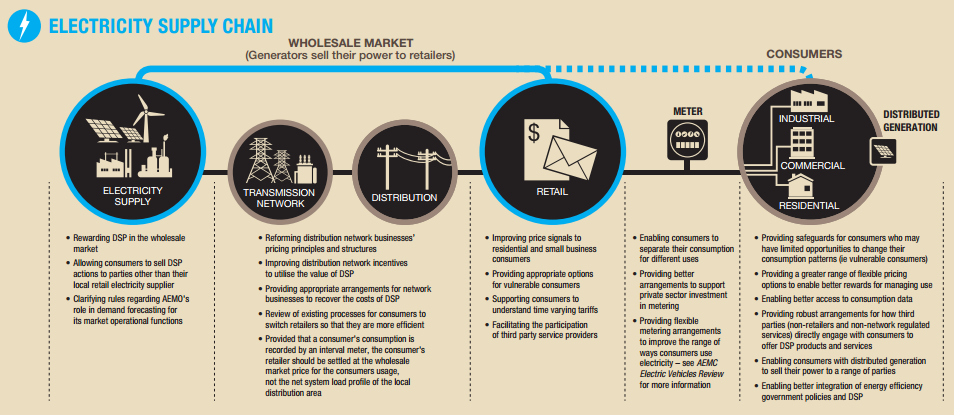Why don’t retailers offer higher solar feed-in rates? Does it matter if feed-in tariff rates are low? What are some of the alternative approaches to conventional feed-in tariffs that are beginning to appear in the Australian market? These are important questions to ask when considering going solar in Australia these days. We take a look at some of the answers in this article.
Shouldn’t electricity retailers just offer higher feed-in tariffs?
These days, solar feed-in tariffs in most states (8-12c/kWh) are significantly lower than the rates that households pay for their electricity from the grid (20-45c/kWh).
Many solar households are understandably disgruntled by the fact that solar feed-in rates are so low. On a gut level, it feels wrong that a unit of their solar energy can leave their house to the tune of 8c to be delivered to their neighbour magically marked up to 25c.
The two points below help to explain why a retailer won’t pay you the full retail rate for your exported solar energy.
N.b. This article was originally published in Feb 2017. It has since been updated.
Compare solar & battery storage quotes from installers in your area!
Compare Solar & Battery Quotes
- The 25c/kWh that you pay for electricity that you purchase consists of several components: the wholesale price of electricity (which changes every half hour), ‘network’ fees for using the grid, government ‘green schemes’ and of course the electricity retailer’s own operating costs and profits. Offering the full retail value for customers’ solar exports is a guaranteed trip to bankruptcy-ville. (N.b. The generous solar feed-in tariffs of yesteryear were not ‘naturally’ high – they were subsidised to provide an incentive for people to go solar when solar was still expensive.)
 An explanation of the various components that make up electricity prices. (Via AEMC / Power of Choice Review.)
An explanation of the various components that make up electricity prices. (Via AEMC / Power of Choice Review.)
- To a retailer, the solar energy you put into the grid is ‘raw’, wholesale electricity, and therefore only worth as much as the going spot price on the National Electricity Market (NEM). There’s a lot of solar power in Australia, and its presence has put marked downward pressure on wholesale electricity prices during the middle of the day – when most solar systems are going full bore. This unfortunately means that your exported solar energy usually isn’t worth much to your retailer. Most feed-in tariffs rates these days are based on forward-looking projections of future spot market prices. Paying you a significantly higher rate could result in losses for them (unless they make up for it by increasing other parts of your bill).
Electricity prices by capital city: A snapshot
The table below (composed using data from EnergyMadeEasy.gov.au and other state/territory government websites) shows some of the going electricity prices in Australia’s capital cities. Canberra is home to the lowest electricity prices in the nation. Ironically, this makes them less attractive places for solar power, as their savings will be relatively low as compared to cities with higher electricity prices. (Check out our Simple Solar PV System Payback Estimator Tool.)
City Electricity consumption charge ($/kWh incl GST) Adelaide $0.34 Brisbane $0.21 Canberra $0.20 Darwin $0.26 Hobart $0.26 Melbourne $0.21 Perth $0.27 Sydney $0.25
 What about the companies that do offer higher feed-in tariffs?
What about the companies that do offer higher feed-in tariffs?
The point is that in current market conditions, most electricity retailers can’t justify offering a high solar feed-in tariff from a business perspective; while wholesale electricity prices are volatile, are usually quite low during the sunniest parts of the day.
Conversely, retailers do not generally offer higher feed-in rates without jacking up other components of your bill (e.g. the daily supply charge). As we’ve said before, a higher feed-in tariff does not automatically translate into a ‘solar-friendly’ electricity retailer – caveat emptor, beware of Greeks bearing gifts, etc.
That being said, a number of truly solar-friendly retailers do give a higher rate than others – but don’t make the decision to switch without inspecting all aspects of the package on offer. (Check out our Solar-Friendly Retail Electricity Plan Comparison Tool.)
Can’t the government do something about it?
In fact, some state governments do mandate minimum rates (as in Victoria and previously South Australia), and some are even pushing to ensure that additional value is tacked on to solar exports (e.g. environmental value or local network value). It is important that solar is fairly valued, and these are two examples of the oft-ignored ways in which distributed solar PV delivers real value to the system as a whole but not necessarily to the owners themselves. Advocacy group Solar Citizens are pushing for this sort of change with their ‘Fair Price for Solar’ campaign.
It’s highly unlikely, however, that any government-mandated increase in solar export rates will have a significant impact on the financial case for exporting solar. Let’s say, for example, that a state government implemented a policy that sets a mandatory payment for environmental and local benefits of solar on the grid. Realistically, we’d be looking at a ‘value stack’ that firstly takes into account the wholesale value of the solar energy, plus these other auxiliary benefits. The wholesale value would presumably be hedged forward to give a flat rate instead of a constantly fluctuating one. In the end, solar system owners might end up getting paid 10c/kWh (or, very optimistically 15c/kWh) for their excess energy. This would undoubtedly be much more fair for sure, but solar self-consumption would even then most likely deliver the bigger savings.
Key takeaway: Solar self-consumption will continue to be the best way to save money…
The point is this: Even if a retailer does offer a higher feed-in tariff – whether voluntarily or because the government makes them – solar system owners would still be better off keeping their solar energy to themselves. A higher feed-in tariff would mitigate the bleeding of valuable solar energy into the grid – but wouldn’t they be better off not bleeding in the first place? This dynamic explains the rising popularity of battery storage, solar diverters and energy management systems. It’s doubtful that increases to solar feed-in tariffs will be significant enough to change it.
…but solar homes are already forming a new relationship with the grid
While we may never again see a situation in Australia where solar system owners are incentivised to put all of their solar into the grid (as was formerly the case under the NSW Solar Bonus Scheme), it’s already a reality that some system owners have the incentive to do so selectively. More often than not this incentive is market-based instead of government-mandated.
There have already been two notable examples of this sort of market innovation in action in Australia. In both cases, solar/battery homes & businesses receive benefits directly linked to the electricity spot market price.
Screenshot from the Reposit Power app.
The first is Reposit Power, a battery technology company whose platform lets battery system owners receive premium rates for stored energy that they send into the grid at select times – we’ve dubbed this type of program ‘selective export‘. The company has partnered with several electricity retailers for specific offerings, but their software platform is open-ended enough for retailers to leverage it to capture value that would otherwise be inaccessible to solar/battery system owners.
The other was Urth Energy, who offered a retail electricity plan that essentially passed through the wholesale electricity spot price to their customers as a sort of variable feed-in tariff. This would allow anyone with a solar system – with or without batteries – to opt to export energy when spot prices were high, whilst aiming to maximise self-consumption when prices were low. The company has since gone into administration (for reasons unrelated to this plan), but it’s feasible that another company (or companies) could offer a similar package, ideally coupled with an energy management system.
In addition to these two, there are dozens of other companies with ground-breaking products in the works that promise to revolutionise the way households interact with the grid. Watch this space: we expect the announcements to come fast this year!
Compare solar & battery quotes from providers in your area
Compare Solar & Battery Quotes
© 2019 Solar Choice Pty Ltd
- Running Cost of Air Conditioners – Explained - 7 October, 2025
- Air Conditioner Rebate South Australia: What You Need to Know - 19 September, 2025
- Air Conditioner Rebates in Queensland: What You Need to Know - 19 September, 2025
